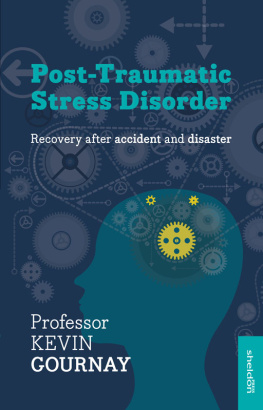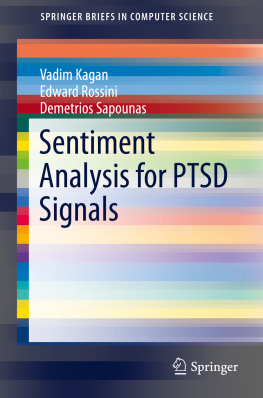
I am deeply indebted to a number of individuals who I have encountered throughout my professional life. First are those who served as mentors and left their professional mark on me. Their names are well known within their respective fields, and in listing them I run the risk of name-dropping. However, my contact with each was of sufficient length and substantive nature to merit my genuine gratitude and a public thank you. In order of encounter: Drs. Thomas McLellan, Arthur Alterman, Albert Stunkard, Kelly Brownell, Manfred Meier, James Mitchell, and William Carpenter Jr.
I have been fortunate to be associated with one of the premier research institutions in the world, the Maryland Psychiatric Research Center. Colleagues I've had the pleasure of working with and learning from include Drs. Gunvant Thaker, Brian Kirkpatrick, Robert Buchanan, and Carol Tamminga.
In my home department here at Indiana University of Pennsylvania, Drs. Don Robertson and Krys Kaniasty deserves many thanks.
A special group of friends and colleagues are particularly deserving of note: Drs. Adrienne Lahti, Rosy Roberts, and the late Dr. Bob Lahti.
Finally and perhaps most importantly, thanks to my family, who suffered through years of this book.

Keep in mind that depending on the person, these features will combine in a variety of ways such that no two paranoid individuals look the same. Thus, some features may be more prominent or nonexistent in one person compared to another.
mistrust or suspicion of others motives
aloof; doesn't get deeply emotionally involved
anxious, fearful, worrisome
bears grudges and seeks revenge
belief in malevolent others, known or unknown, who abuse, torment, harass, threaten, wrong, vilify, accuse, disparage, mistreat, persecute, and taunt them
belief that one is being talked about, followed, stared at, or watched
belief that others will harm, injure, or kill them
belief in a conspiracy involving one or more persons or organizations (e.g., Mafia, CIA)
belief that they are being intentionally bumped or jostled when in crowds
black-and-white way of viewing things
constant mobilization and vigilance for perceived threats
constantly calling the police to complain about things
conviction that someone will do them harm
defensive
often dwelling on these issues in their imagination
edgy, irritable, quarrelsome, and querulous demeanor
emotionally cold and detached
evasiveness; moves away from people
everything means something; no chance occurrences
excessive sense of self-importance
feeling wronged by others
flaring up when certain touchy subjects are brought up or even alluded to
frequent references to listening, looking, and monitoring devices including by x-rays, radio waves, microwaves, computers, and computer chips that have been implanted
grandiosity
guarded
high levels of anger
hostility
hostility occasionally erupts into verbal or physically violent outbursts
humorlessness
hypersensitivity, which results in self-references even when no reference is actually made (ideas of reference)
hypervigilance
inference of maliciousness based on specious reasoning
inferential leaps based on insignificant details
jealousy
lack of trust
litigiousness
looking for threats
making mountains out of molehills
often hard people in the sense that it is a dog-eat-dog world, so they don't expect breaks and don't cut any either
overly concerned with evidence
persecutory delusions
rigid and fixed beliefs that are not modified by evidence to the contrary
rigidity
secretiveness
susceptibility to slights (intended or unintended) by others

SUBSTANCES
ACTH
Actifed
Albuterol
alcohol intoxication
alcohol withdrawal
alcohol hallucinosis
alpha-Methyldopa
amphetamines
anticholinergic drugs
antimalarial drugs
antitubercular drugs
arsenic
atropine toxicity
barbiturates
bromide intoxication
Bromocriptine
Bupropion
carbon monoxide poisoning
Cimetidine
cocaine
Contac
cortisone
DDAVP
Diphenylhydantoin
disulfiram (Antabuse)
ephedrine
ibuprofen
imipramine
indomethacin
levodopa
lidocaine
LSD
manganese
marijuana
mephentermine
Methylphenidate (Ritalin)
mercury
mescaline
methyltestosterone
nasal decongestants
nitrous oxide
pentazocine
pervitin
phencyclidine (PCP)
phenylpropanolamine
prednisone
procaine penicillin
propylhexedrine
propranolol
salbutamol
thallium
CONDITIONS
acute intermittent porphyria
Addison's disease
AIDS
Alzheimer's type dementia
bipolar disorder
cerebrovascular disease
Creutzfeldt-Jakob disease
Cushing's syndrome
delirium
encephalitis lethargica
epilepsy (temporal lobe origin)
Fahr's disease
fat embolism
folate deficiency
hearing loss
hemodialysis
hepatic encephalopathy
herpes simplex encephalitis
HIV infection
Huntington's chorea
hydrocephalus
hypercalcemia
hypertensive encephalopathy
hyperthyroidism
hypoglycemia
hyponatremia
hypoparathyroidism
hypopituitarism
hypothyroidism
Klinefelter's syndrome
leukoencephalopathy
liver failure
malaria
malnutrition
Marchiafava-Bignami disease
Menzel-type ataxia
metabolic encephalopathy
metachromatic leukodystrophy

Alzheimer's disease
Lewy body dementia
Pick's disease
frontotemporal dementia
dementia associated with Parkinson's disease
vascular dementia
primary progressive aphasia
semantic dementia
AIDS Dementia Complex
dementia associated with tertiary syphilis
dementia associated with Huntington's disease
Amyotrophic lateral sclerosis
Creutzfeldt-Jakob disease
normal pressure hydrocephalus
Binswanger's disease
Wernicke-Korsakoff syndrome
dementia due to repeated traumatic brain injury
herpes encephalitis
corticobasal degeneration
Fatal Familial Insomnia

(A complete bibliography of over seven hundred references used in preparing this book is available upon request from the author)
Aiello, L. C., and R. I. Dunbar. Neocortex Size, Group Size, and the Evolution of Language. Current Anthropology 34, no. 2 (1993): 18493.
Amerithrax Investigative Summary. Department of Justice. June 2000.
Amphetamine and Methamphetamine Emergency Department Visits, 19952002. Drug Abuse Warning Network. July 2004.
Andryszewski, T. The Militia Movement in America. Brookfield, CT: Brookfield Press, 1997.
Angrist, B. et al. Early Pharmacokinetics and Clinical Effects of Oral D-Amphetamine in Normal Subjects.
Next page

















